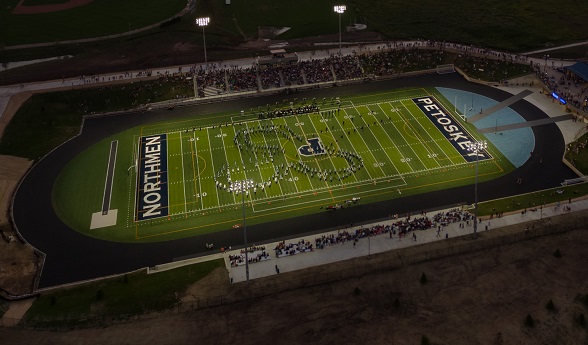
Northmen Stadium Opens to Excitement, 'Awe'
September 1, 2016
By Dennis Chase
Special for Second Half
PETOSKEY – Petoskey kicked off a new era in football last Thursday with the unveiling of Northmen Stadium, a multi-use facility that will be home for football, soccer, lacrosse, band and track & field.
 More than 4,000 spectators turned out on a beautiful late August night to watch Petoskey open its season against Ada Forest Hills Eastern. School officials believe it was the largest home football crowd in Petoskey history.
More than 4,000 spectators turned out on a beautiful late August night to watch Petoskey open its season against Ada Forest Hills Eastern. School officials believe it was the largest home football crowd in Petoskey history.
Even a 35-14 setback could not dampen the enthusiasm and pride displayed by those in attendance.
“To see the stadium from the road is one thing – and that excited people,” Superintendent John Scholten said. “But once they got inside and saw it first-hand, there was an awe factor. It was like, ‘Wow!’”
Northmen Stadium replaces Curtis Field, which was built in 1927 and served as the home for Petoskey football for 88 years.
“Our community is very tradition-oriented, very values-oriented,” Dan Ledingham, president of the football boosters, said. “Curtis Field means a lot to us. It’s very symbolic – the roots from where we started. Multiple generations played on that field. I know families who go three to four generations deep. But it was time.”
“It’s time” was actually the theme for the $10 million bond proposal that the electorate approved by a 64 to 36 percent vote in 2014.
“It (Curtis Field) served the community well, but it was pretty tired,” Scholten said.
In addition to the $10 million bond, the school received significant donations and coordinated efforts with other sinking fund projects.
“The whole (campus) renovation is closer to $15 million,” Scholten said.
The project includes the stadium, reconstruction of six tennis courts, a rebuilt softball field, two new soccer practice fields, and a cross country 5K trail that ties into a community walkway and includes three culvert tunnels under realigned Northmen Drive.
It’s all part of a concerted effort to bring the school’s athletic facilities – once scattered around the city – to the campus location. The school had already built a stunning new high school gymnasium and an on-site baseball field.
“When I moved up here (from Maple City Glen Lake) two of the old icons from the Glen Lake days, Denny Dame and Ivan Ford, said you’re moving to the nicest gym in the north,” Scholten said. “I’m a little biased, but I think we now have one of the nicest football facilities in the north, too.”
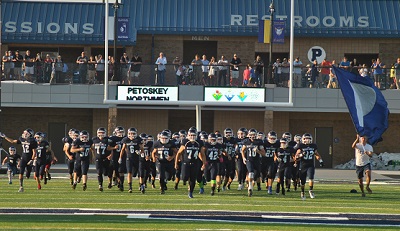 The stadium is the centerpiece of the latest project. The property’s topography featured a “semi-natural bowl” on the southeast side. Construction workers moved 300,000 cubic yards of dirt to build up the other side, creating a complete bowl appearance.
The stadium is the centerpiece of the latest project. The property’s topography featured a “semi-natural bowl” on the southeast side. Construction workers moved 300,000 cubic yards of dirt to build up the other side, creating a complete bowl appearance.
“The fact it sits down in a bowl makes it unique,” athletic director Dave Smith said. “There are lots of places that have nice stadiums, but they’re flat and the bleachers go up. With this, there’s not a bad seat in the house because it sits down in that bowl.”
The main entrance is near the mezzanine in the north end zone, which is where the concessions and restrooms are located. It features a plaza that overlooks the field. A tunnel runs underneath the mezzanine where the players and band enter and exit the field.
“It’s a very cool place to see a game,” football coach Kerry VanOrman said. “When the band marches through the tunnel, it’s like you’re at Michigan State or Michigan.”
Team rooms, a training room and an officials room are located off the tunnel.
A 40-foot video scoreboard anchors the south end zone. There’s also a messaging board attached to the mezzanine.
The synthetic turf is lined for football, soccer and lacrosse. The soccer team opens its home season Tuesday.
The stadium seats 2,950, but there is additional lawn seating on the hillside. Plus, based on opening night, fans seem to enjoy watching from the mezzanine.
“That elevation overlooking the field gives you the best view,” Ledingham said. “You can see everything, and you can feel the energy coming from the crowd.”
Workers scrambled to get the stadium ready for opening night. In fact, just 48 hours beforehand Ledingham wondered if it would be game ready.
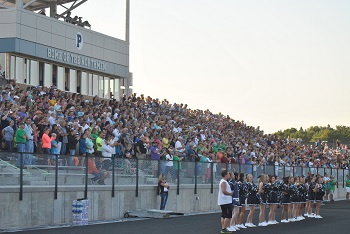 “There were tractors and trucks, concrete and tiles,” he said. “Everything was everywhere. It looked like a true construction site that maybe in a month would be close (to done). I was wondering, ‘What’s Plan B?’ Kent (Cartwright, the school’s chief financial officer) said, ‘There is no Plan B. We are on this field.’ It was neat to see it all come together.”
“There were tractors and trucks, concrete and tiles,” he said. “Everything was everywhere. It looked like a true construction site that maybe in a month would be close (to done). I was wondering, ‘What’s Plan B?’ Kent (Cartwright, the school’s chief financial officer) said, ‘There is no Plan B. We are on this field.’ It was neat to see it all come together.”
Smith agreed.
“It was unbelievable the number of people there, from the construction crew to the subcontractors, working extra hours, late hours, that last month to make sure we could get in there and play on that (Thursday),” he said. “Two days out, I was also wondering how this is going to happen. But it did.”
The school received a temporary occupancy permit to open the stadium. Finishing touches were still being completed this week.
The opening culminates nearly 10 years of work. A bond proposal to fund separate football and soccer stadiums was rejected by voters in 2007.
“We had a nice plan,” Scholten said, “but it was just when the recession was starting. We did all the pre-work with the surveys and it looked like the confidence was there, but when the economy went south, (the vote) went south, too.”
Officials regrouped and, after the lingering recession ended, pared back the plan and took it to the voters.
“It was unfortunate timing (in 2007),” VanOrman said. “They were smart in waiting for things to pick up. They did a good job planning it, locating it and even tying it into the city walkways. It kind of includes everybody into it.”
Officials changed the location of the stadium, building it on what was two practice fields so it could utilize existing locker rooms and showers at the school. Two additional locker rooms will be added.
“We listened to the community,” Scholten said. “We were a little extravagant (in 2007) so we came back with a different plan. We worked real hard to say, ‘We listened to you, we trimmed it back, we feel we’re being responsible.’ We worked hard to build that confidence back up.”
The cross country trail will facilitate skiers as well as runners and walkers. The new eight-lane track replaces the outdated six-lane version at Curtis Field.
“We couldn’t host anything big because of that,” Scholten said.
Scholten expects the new facility will make Petoskey an attractive choice for hosting MHSAA tournaments.
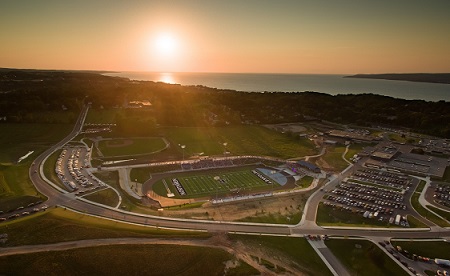 Parking, an issue at Curtis Field, was addressed, too. Spectators can now use the high school and middle school lots, as well as new parking spaces near the stadium.
Parking, an issue at Curtis Field, was addressed, too. Spectators can now use the high school and middle school lots, as well as new parking spaces near the stadium.
The improvements now leave hockey and downhill skiing as the only sports played off campus, Smith said.
“From an athletic director’s standpoint, I love how most of our facilities are now on school grounds,” he said.
He also loves the positive buzz the stadium’s generated. Ledingham called opening night “surreal.”
“It was amazing to see our community come together to enjoy it,” he said.
The unveiling attracted fans from nearby communities as well.
“The energy and support was great,” junior kicker Noah Ledingham said. “You run on to that field, see the lights, see (the crowd) and it just makes you want to play harder.
“To be the first team to play on that field is an amazing feeling because it’s a new chapter (in Petoskey football) and you know you’re making history.”
The Northmen, with just two key returnees back, struggled early, falling behind Forest Hills Eastern 28-0 before rallying to make it a game.
“I was pleased with the way we played in the second half,” VanOrman said. “It was 28-14 with 3:30 left in the game. We went for an onside kick and it blew up in our face. They recovered and ran it back to our 15 and then scored. (Eastern’s) a good football team. It was a good measuring stick for us to see where we have to get better.”
The night might also pay dividends. Forest Hills Eastern officials are talking about extending the two-year deal with Petoskey that is set to expire after the Northmen travel down there next season.
“They liked it so much they want to come back in two years,” Smith said. “I would say that’s a compliment right there.”
 Dennis Chase worked 32 years as a sportswriter at the Traverse City Record-Eagle, including as sports editor from 2000-14. He can be reached at [email protected] with story ideas for Manistee, Wexford, Missaukee, Roscommon, Ogemaw, Iosco, Alcona, Oscoda, Crawford, Kalkaska, Grand Traverse, Benzie, Leelanau, Antrim, Otsego, Montmorency, Alpena, Presque Isle, Cheboygan, Charlevoix and Emmet counties.
Dennis Chase worked 32 years as a sportswriter at the Traverse City Record-Eagle, including as sports editor from 2000-14. He can be reached at [email protected] with story ideas for Manistee, Wexford, Missaukee, Roscommon, Ogemaw, Iosco, Alcona, Oscoda, Crawford, Kalkaska, Grand Traverse, Benzie, Leelanau, Antrim, Otsego, Montmorency, Alpena, Presque Isle, Cheboygan, Charlevoix and Emmet counties.
PHOTOS: (Top) Petoskey's stadium, at dusk, hosted Ada Forest Hills Eastern for its debut. (Middle above) The Northmen take to their new field for the first time. (Middle below) Fans packed the home stands, which are part of a "bowl" circling the playing surface. (Below) The new football field is just one part of the renovated Petoskey athletic complex. (Aerial photos by Charles Dawley/Up North Imaging. Game photos by Scott Moore.)
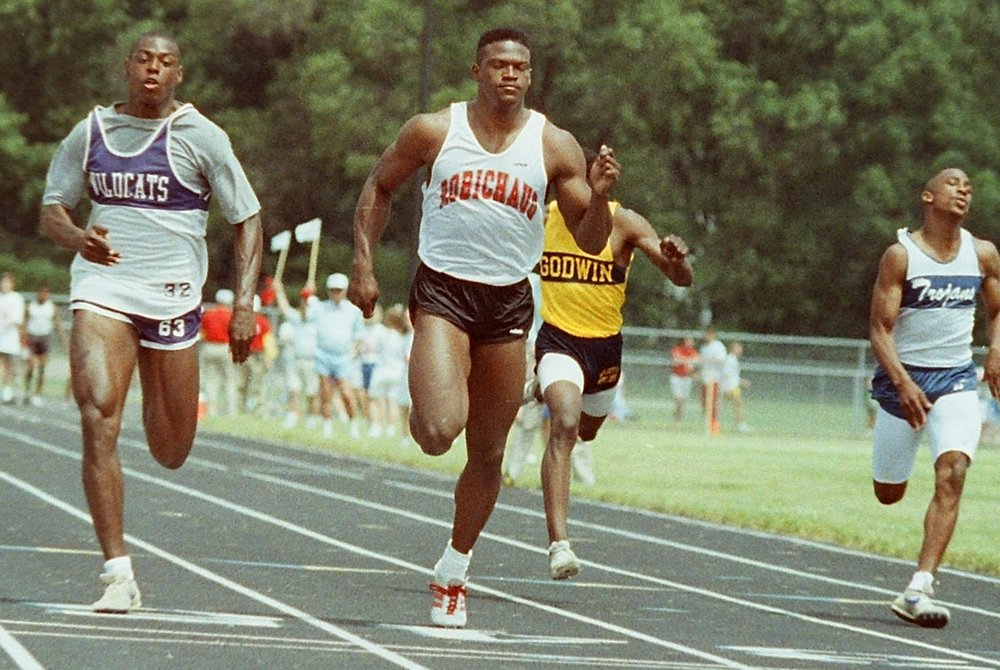
Robichaud 3-Sport Legend Wheatley Selected to National High School Hall of Fame
By
Geoff Kimmerly
MHSAA.com senior editor
March 11, 2024
The playing career of 1991 Dearborn Heights Robichaud graduate Tyrone Wheatley remains one of the most storied in Michigan high school sports history. His prestige gained during that early stage of his athletic stardom has been recognized nationally as well, as Wheatley was one of 12 honorees announced today as this year’s inductees into the National High School Hall of Fame by the National Federation of State High School Associations (NFHS).
Wheatley – who grew up in Inkster and is currently the head football coach at Wayne State University – will be inducted as one of 11 honorees selected for the 41st Hall of Fame class at a ceremony during the NFHS summer meeting July 1 in Boston. The rest of the class is made up of three more athletes, four coaches, two former state association administrators and a game official. Wheatley was nominated by the Michigan High School Athletic Association.
Wheatley will become the Hall of Fame’s 10th inductee from Michigan, joining the MHSAA’s first full-time Executive Director Charles E. Forsythe (inducted 1983), River Rouge boys basketball coach Lofton Greene (1986), Warren Regina athletic director, softball and basketball coach Diane Laffey (2000), Fennville basketball and baseball standout Richie Jordan (2001), Grosse Pointe Woods University Liggett boys and girls tennis coach Bob Wood (2005), Bloomfield Hills Cranbrook hockey standout Jim Johnson (2007), Owosso football, basketball and baseball all-stater Brad Van Pelt (2011); Vermontville Maple Valley baseball national record holder Ken Beardslee (2016) and retired MHSAA Executive Director John E. “Jack” Roberts (2022).
To the greater public, Wheatley surely is best known as a star running back for University of Michigan who went on to play 10 seasons in the NFL for the New York Giants and Oakland Raiders. However, he is arguably most glorified in Michigan high school athletics for his accomplishments on the track, where as a junior in 1990 he became the first (of still only two) athletes to win four individual events at an MHSAA Lower Peninsula Finals – placing first in the 100 and 200-meter dashes, 110-meter hurdles and long jump. He led Robichaud to the Class B team title that day, scoring 40 of its 49 points. Wheatley completed his high school career in 1991 with three more Class B individual track & field championships and nine total over his final three seasons; he was injured in the 100 during that senior-year meet and could not run his final race to attempt another four-title day.
Wheatley’s meet records of 13.7 seconds in the 100 at the 1991 LP Class B Final and 23-10¾ in long jump in 1989 still stood when the four-Class track & field format was retired after the 1999 season. He also remains the only athlete to win the 100 three times at the prestigious Mehock Relays in Mansfield, Ohio, also finishing first in the 110 hurdles and 200 and runner-up in the long jump at that meet in 1991.
Wheatley was similarly accomplished on the high school football field, leading his team to a state championship in 1990 and earning a Parade All-America honor. Over three varsity seasons total he ran for a combined 4,257 yards and 67 touchdowns, including 2,010 yards and 33 scores on 208 carries as a senior in 1990 – the latter despite playing quarterback half of that season (and throwing five touchdown passes). He played quarterback, running back, defensive back, punter, kicker and returned kicks, and he scored 252 points over 13 games as a senior and 484 over 38 career games.
Wheatley also was a standout on the basketball court for Robichaud, averaging 14 points and 16 rebounds per game as a senior in earning all-state recognition in that sport as well.
“My city where I come from, Inkster, means the world to me. I grew up in an incredible era of sports in Michigan (with successful University of Michigan and Detroit pro teams) … but if you ask me who my idols were, they were the guys I grew up with playing on the playground,” Wheatley said. “After you come from a basketball game where you see Jarvis Walker drop 30, or Earl Jones running the last 200 of a race backwards … you hear people talk about them, you hear their reverence about them, and I just wanted to be put in the conversation of the best to come out of Inkster, forget the state. I can tell you this for sure: I’m not the best athlete to come out of Inkster, just the person who got the recognition. And my foundation was built watching, taking notes, preparing, working out and just trying to be one of the guys.
“(Robichaud was) the step. Because without Robichaud … Michigan, the NFL, me coming back to coach, it doesn’t happen,” Wheatley said. “Without the Robert Yaucks (his football coach at Robichaud), the Coach (Leit) Jones (his Robichaud track coach), the Coach (Mercer) Brysons, the (coach) Wade Cooks, the (coach Jeff) Flounorys, the Millie Hursins (his academic advisor) of the world, this doesn’t happen. Without my high school teammates, none of this happens. So it’s not just a step. What’s the saying – the first impression is the lasting and best impression? Robichaud was it.”
Wheatley returned to Robichaud as its varsity football coach in 2007 and led that team to a 9-2 record and the MHSAA Playoffs for the first time since 1994 – after Robichaud had finished 0-9 the previous season. He has served as an assistant football coach at four college programs including U-M and Syracuse, and with the Buffalo Bills, Jacksonville Jaguars and Denver Broncos.
He also served as Morgan State University's head coach from 2019-21 and just completed his first season as head coach at Wayne State, which finished 3-8 – an improvement of two wins from 2022 and the program’s best record since 2019.
Wheatley graduated from University of Michigan in 2008 with a bachelor’s degree in kinesiology. He and wife Kimberly have five children: Tyrone Jr., Terius, Tyrique, Tiana and Tamari. Tyrone Jr., an offensive tackle, played this past season for the New England Patriots.
“Many of us who grew up in Michigan grew up as fans of Tyrone Wheatley because of what he accomplished at the college level – but his legendary story begins at Dearborn Heights Robichaud, where his outsized athletic ability was on full display in every sport he played,” MHSAA Executive Director Mark Uyl said. “Michigan has produced several professional athletes in a variety of sports and nearly 50 Olympians in track & field alone, and what Tyrone Wheatley achieved as a high school athlete remains a standard few have approached. We are ecstatic that he will deservedly take his place among the all-time elite high school athletes nationally as well.”
The National High School Hall of Fame was started in 1982 by the NFHS. The 11 individuals were chosen after a two-level selection process involving a screening committee composed of active high school state association administrators, coaches and officials, and a final selection committee composed of coaches, former athletes, state association officials, media representatives and educational leaders. Nominations were made through NFHS member associations. Also chosen for this class were athletes Joe Mauer (Minnesota), Takeo Spikes (Georgia) and Dot Ford Burrow (Mississippi); sport coaches Paula Kirkland (South Carolina), Gary Rankin (Tennessee), Roy Snyder (Pennsylvania) and Ronald Vincent (North Carolina); former state association administrators Mike Colbrese (Washington) and Marie Ishida (California), and baseball/football game official David Core (Oklahoma).
For more on this year’s Hall of Fame class, visit the NFHS Website.
PHOTO Tyrone Wheatley crosses the finish line first during one of his nine MHSAA Finals track & field championship victories. (MHSAA file photo.)

